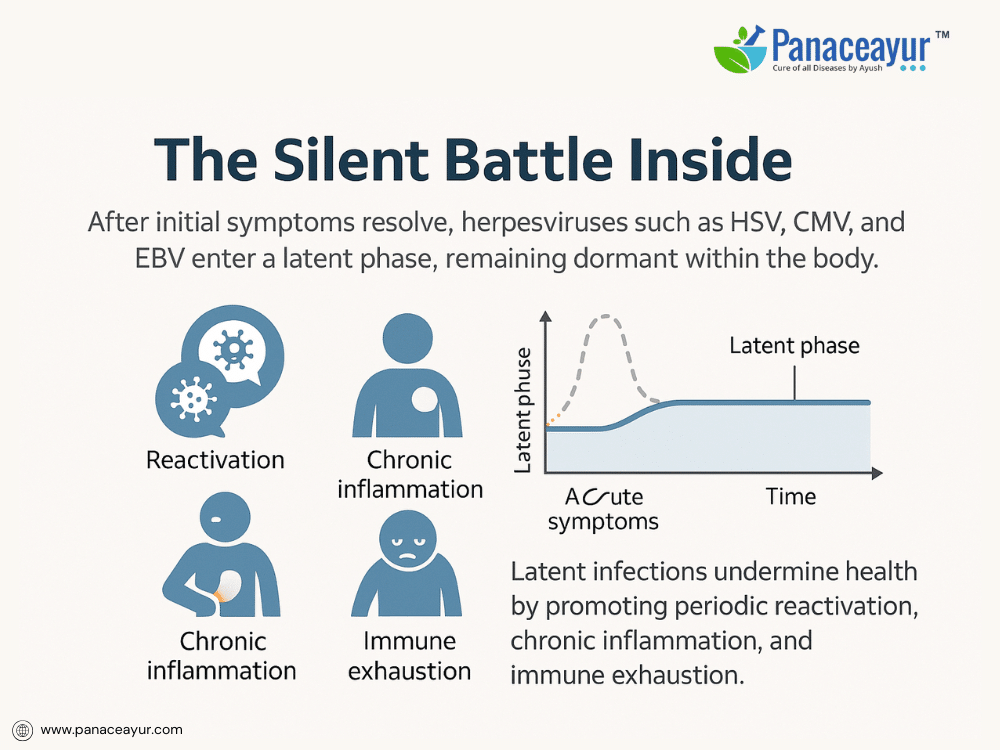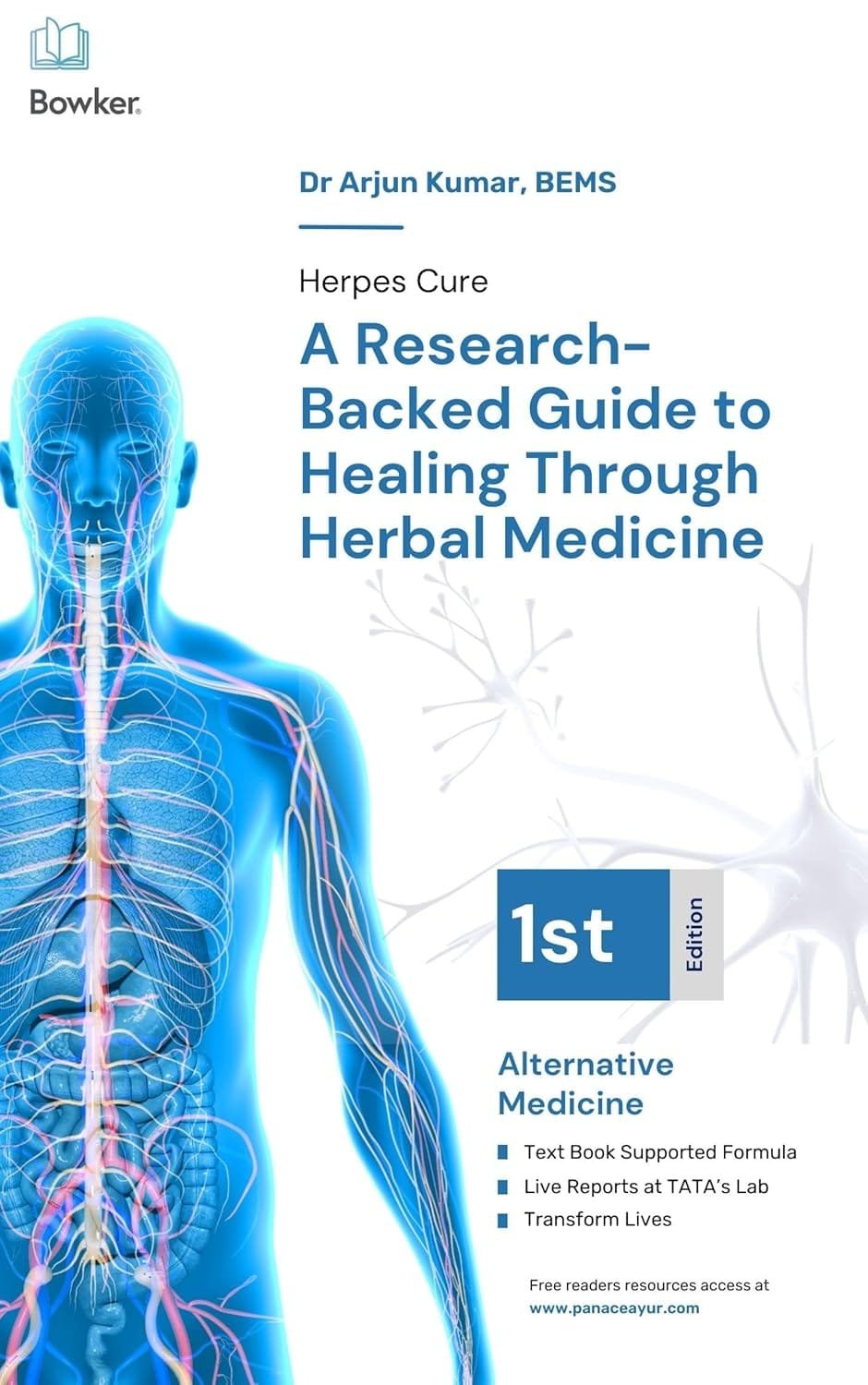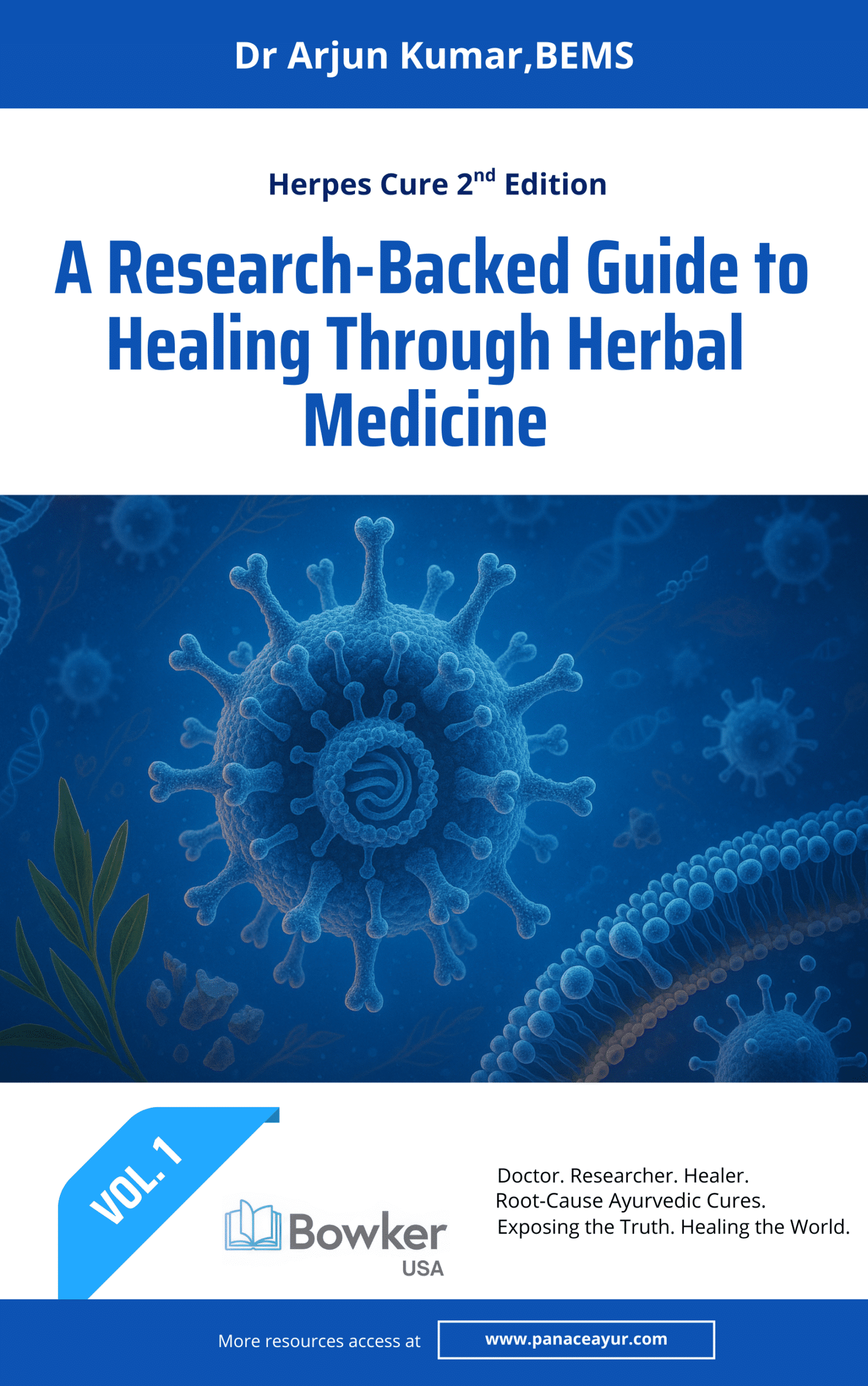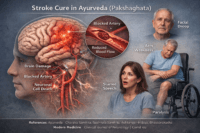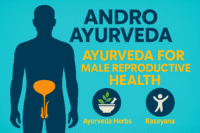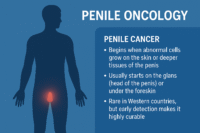- The Silent Battle Inside
- How Modern Antiviral Drugs Work
- 2.1 Mechanism of Action
- 2.2 Limitations of Antivirals
- 2.3 Development of Drug Resistance
- Modern Medicine’s Struggle with Latent Infections
- Healing the Terrain
- How Ayurveda Reaches and Clears Latent Viruses
- Scientific Research
- Clinical Experiences
- Eradication vs Suppression
- References
The Silent Battle Inside
The story of viral infections does not end with the resolution of initial symptoms. For millions worldwide, the true battle begins only after the fever subsides, the sores heal, and apparent health is restored. Hidden deep within the body, viruses such as herpes simplex virus (HSV), cytomegalovirus (CMV), and Epstein-Barr virus (EBV) continue their existence in a latent form, evading detection and elimination by the immune system. This silent survival strategy allows them to persist for decades, reactivating periodically and undermining long-term health.
Modern medicine has made significant advances in diagnosing and controlling acute viral infections. Antiviral drugs can suppress active replication, shorten the duration of outbreaks, and provide symptomatic relief. However, the latent phase remains largely untouchable. Antiviral therapies, no matter how potent during active infection, fail to eradicate viruses hidden in nerve ganglia or lymphoid tissues. These dormant viruses remain integrated within the body’s systems, protected from both pharmacological intervention and immune clearance.
The persistence of latent viruses is not merely a scientific curiosity; it has profound implications for long-term health. Latent infections contribute to chronic inflammation, immune exhaustion, recurrent disease episodes, and, in some cases, the development of more serious complications over time. The psychological burden of knowing that a virus remains permanently embedded in the body adds further to the physical toll.
This reality calls for a paradigm shift in how viral diseases are approached. Suppression of active symptoms is not equivalent to cure. True healing demands strategies that address the latent reservoirs, regenerate damaged tissues, and restore the body’s internal environment to a state that no longer supports viral persistence.
Ayurveda, with its deep understanding of latent diseases, provides a comprehensive framework for achieving this. By correcting the underlying terrain, rejuvenating the Dhatus (tissues), and enhancing immune intelligence, Ayurveda offers a path to true viral freedom—something modern antiviral drugs, by their very design, cannot accomplish.
This blog will explore why modern antiviral therapies fail against latent infections, how Ayurveda succeeds where suppression falls short, and why a terrain-based approach is essential for achieving complete and lasting recovery.
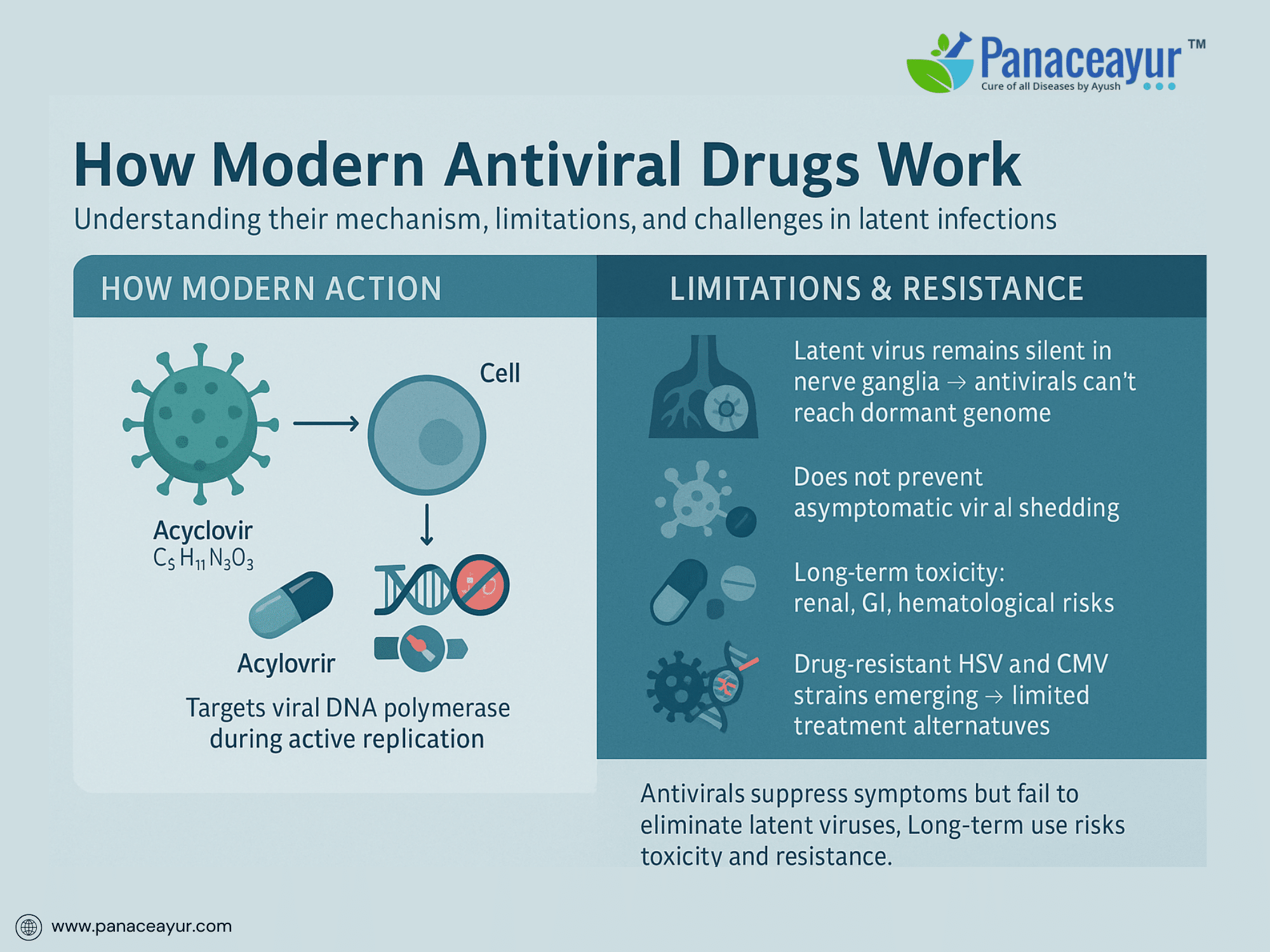
The development of antiviral drugs marked a significant milestone in the management of infectious diseases. For viruses like herpes simplex virus (HSV), cytomegalovirus (CMV), and Epstein-Barr virus (EBV), modern pharmacology has created compounds that can significantly reduce the severity of active outbreaks and, in some cases, prevent frequent recurrences. However, the success of these drugs is largely confined to managing viral replication during the active phase. Their mechanisms reveal inherent limitations that explain why they are ineffective against latent infections.
2.1 Mechanism of Action
Most antiviral medications target the virus during its replication cycle, a phase where viral DNA synthesis and protein production are at their peak. For example, acyclovir (C₈H₁₁N₅O₃), a cornerstone drug in herpes management, functions as a nucleoside analog. Once activated inside infected cells, it incorporates into viral DNA chains, halting further replication by inhibiting the viral DNA polymerase enzyme. Other related drugs, such as valacyclovir and famciclovir, operate through similar pathways.
While this mechanism is effective during active outbreaks—when viruses are reproducing and assembling new virions—it is powerless against latent viruses. During latency, viral genomes reside silently within host cells, particularly neurons in the case of HSV, without active replication. There is minimal or no production of viral proteins, and the virus remains transcriptionally inactive. Because antiviral drugs rely on targeting viral enzymes involved in replication, their effect ceases once the virus enters dormancy.
The fundamental limitation of modern antivirals is their inability to affect latent reservoirs. While they can reduce the frequency, severity, and duration of active outbreaks, they do not touch the hidden virus embedded within nerve ganglia or lymphatic tissues. Consequently, lifelong therapy becomes the only means of managing symptoms, not curing the infection.
Moreover, antiviral drugs do not fully prevent asymptomatic viral shedding. Even when patients are symptom-free, HSV can intermittently reactivate and shed from mucosal surfaces, posing risks of transmission to others. This incomplete control creates a false sense of security and perpetuates the spread of the virus despite regular treatment.
Another concern is the toxicity associated with long-term antiviral use. Chronic suppression therapy has been linked to renal dysfunction, gastrointestinal disturbances, and, in rare cases, hematological side effects. For individuals who require indefinite antiviral treatment, the cumulative burden on organ systems cannot be ignored.
2.3 Development of Drug Resistance
Viral resistance to antiviral drugs is an emerging challenge, particularly in individuals on long-term therapy or those with compromised immune systems. Resistance develops when mutations arise in the viral DNA polymerase gene, rendering the drug ineffective. Resistant strains of HSV and CMV are increasingly reported, particularly in patients undergoing immunosuppressive therapies or those with HIV/AIDS.
Once resistance develops, therapeutic options narrow significantly. Alternative antiviral agents like foscarnet and cidofovir, which have broader but more toxic profiles, may be employed. However, these drugs come with severe risks, including nephrotoxicity and bone marrow suppression.
The emergence of drug-resistant viral strains highlights a deeper problem: the strategy of symptom suppression without addressing the root cause—viral latency—inevitably leads to adaptation and evasion by the virus.
In summary, while modern antiviral drugs offer temporary symptomatic relief, they do not address the core issue of viral persistence. Their limited action on the replicative phase, combined with risks of resistance and long-term toxicity, underscores the urgent need for approaches that go beyond suppression and aim for true biological clearance of latent infections.
Modern Medicine’s Struggle with Latent Infections

Despite significant advancements in virology and pharmacology, modern medicine openly acknowledges its inability to cure latent viral infections. Scientific literature, clinical guidelines, and public health statements all reflect the stark reality that once a virus like HSV, CMV, or EBV has established latency, it remains permanently embedded within the host unless extraordinary intervention occurs—an intervention modern pharmacology currently cannot provide.
The Centers for Disease Control and Prevention (CDC) states unequivocally that herpes simplex virus infections are lifelong. While antiviral medications can reduce the frequency and severity of outbreaks, they do not eliminate the virus from the body. The World Health Organization (WHO) similarly emphasizes that herpesviruses, once acquired, remain with the individual for life, with potential for reactivation under various physiological or psychological stresses.
The reason for this limitation lies in the nature of latency itself. During latency, viral genomes persist silently within specific host cells, often neurons or lymphocytes, without producing infectious particles. No current antiviral drug effectively penetrates these cells in a way that targets or eradicates the dormant viral DNA. Furthermore, the viral genome is cleverly maintained in a stable, episomal form that mimics host DNA, making it invisible to immune detection and inaccessible to pharmacological attack.
Even sophisticated molecular diagnostic tools such as polymerase chain reaction (PCR) have their limits. While PCR can detect active viral DNA during replication phases or shedding episodes, it often fails to detect latent viruses because they are present at extremely low copy numbers and without active replication. Similarly, serological tests measuring IgG and IgM antibodies indicate exposure and immune response but provide no information about whether the virus has been cleared or is still hiding within the tissues.
This diagnostic gap leaves patients in a difficult position. They may receive a diagnosis of lifelong infection based on a single positive antibody test, with little hope offered beyond lifelong antiviral management. Patients are often advised to “live with the virus” rather than to seek or expect any possibility of cure. This message carries not only medical consequences but profound psychological burdens, fostering fear, anxiety, relationship difficulties, and reduced quality of life.
Furthermore, the model of lifelong viral management through suppressive therapy comes with economic implications. Pharmaceutical dependence ensures a continual market for antiviral medications, without a true endpoint in treatment. In this sense, the incurability of latent viral infections serves as both a scientific limitation and a structural feature of the modern healthcare economy.
Thus, while modern medicine excels in the management of acute viral infections and the reduction of immediate symptoms, it falls short of offering a curative pathway for patients suffering from the long-term burden of viral latency. This admission, both explicit and implicit within scientific and clinical discourse, points to the necessity of alternative paradigms that do not merely suppress symptoms but fundamentally alter the body’s internal environment to prevent viral persistence.
Ayurveda, with its focus on correcting the terrain rather than targeting the virus directly, offers such an alternative—one rooted in deep biological understanding and centuries of clinical experience.
Healing the Terrain

While modern medicine directs its focus toward suppressing viral replication, Ayurveda approaches chronic viral infections from a fundamentally different perspective. Rather than attempting to destroy the virus directly, Ayurveda seeks to correct the internal environment—the terrain—within which the virus survives. It recognizes that pathogens thrive only in tissues that are weakened, obstructed, or energetically imbalanced. By restoring harmony at the level of the Dhatus (body tissues), Srotas (microchannels), and Agni (digestive-metabolic fire), Ayurveda systematically dismantles the conditions that allow latent viruses to persist.
The concept of Beejabhava Dosha is central to Ayurveda’s understanding of latent infections. Beejabhava Dosha refers to the seed-like potential of disease embedded within the body, often inherited or acquired early in life. In the case of viral infections, the latent virus represents such a seed—an invisible threat waiting for favorable conditions to reactivate. Ayurveda does not consider the mere absence of symptoms as true health; rather, it insists on identifying and removing the hidden seeds of disease before they sprout into active pathology.
Srotorodha, or blockage of the body’s microchannels, plays a crucial role in the survival of latent viruses. These channels, responsible for transporting nutrients, waste, and vital energies, can become obstructed by Ama (toxic metabolic byproducts) resulting from improper digestion, stress, unhealthy diets, or environmental toxins. When Srotas are blocked, tissues become poorly nourished and immune surveillance is impaired, creating sheltered niches where viruses can remain hidden and inactive.
Dhatu Dushti, the pathological weakening or corruption of the body’s tissues, further contributes to viral latency. Majja Dhatu (nervous tissue and marrow), Rakta Dhatu (blood), and Rasa Dhatu (plasma and lymph) are particularly affected in herpes, CMV, and EBV infections. When these Dhatus lose their integrity, they not only become incapable of resisting viral invasion but also provide a favorable medium for viral survival and reactivation.
Rather than targeting the virus directly, Ayurveda focuses on:
- Clearing Ama and reopening Srotas to restore optimal tissue nourishment and waste elimination.
- Strengthening and regenerating the Dhatus to remove weak tissues that harbor latent viruses.
- Reigniting Agni at all levels—digestive, tissue, and cellular—to enhance metabolic clarity and immune vigilance.
- Stabilizing Ojas, the essence of immunity and vitality, to establish long-term resistance to reactivation.
This terrain-centered approach does not aim for temporary suppression but seeks biological transformation. By making the body’s internal environment incompatible with viral survival, Ayurveda facilitates the spontaneous resolution of latency without the need for external aggression against the virus itself.
In effect, Ayurveda shifts the entire focus of healing: from fighting the virus to rebuilding the host. This profound paradigm enables not just management of viral infections but their complete resolution through systemic restoration—a goal that continues to elude modern pharmacological approaches centered around symptom control.
In the context of HSV, CMV, EBV, and similar latent infections, the Ayurvedic model offers a comprehensive, time-tested, and biologically logical pathway to true viral freedom by addressing the root cause: a disturbed internal terrain
How Ayurveda Reaches and Clears Latent Viruses
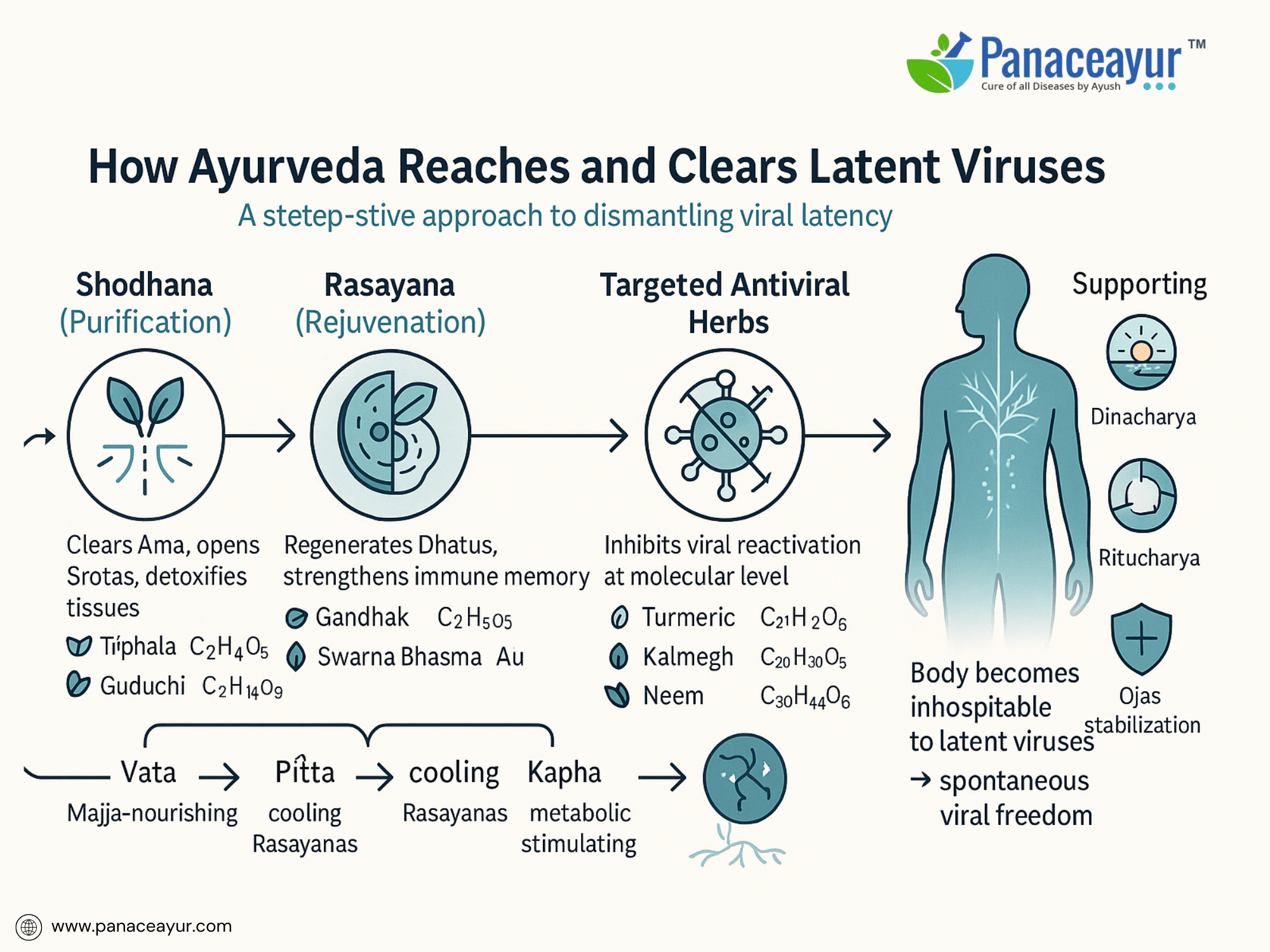
Ayurveda approaches the challenge of viral latency with a systematic, step-by-step healing protocol designed not to attack the virus directly, but to transform the internal environment that sustains it. By purifying obstructed channels, regenerating damaged tissues, restoring immune intelligence, and stabilizing systemic vitality, Ayurveda clears the hidden viral burden in a manner both profound and lasting.
The first step is Shodhana, the strategic purification of the body’s internal pathways. Recognizing that latent viruses thrive in obstructed and toxin-laden tissues, Ayurveda employs detoxification to remove Ama (metabolic waste) and clear Srotas (microchannels). Depending on the patient’s constitution and strength, this may involve gentle internal cleansing with herbal formulations or more classical Panchakarma techniques such as Virechana (therapeutic purgation) to eliminate excess Pitta and metabolic toxins without depleting vital energy. In patients with fragile systems, a slower approach using herbs like Triphala, containing active compounds such as gallic acid (C₇H₆O₅), and Guduchi (Tinospora cordifolia), rich in tinosporaside (C₂₆H₄₄O₈), is preferred to clear internal stagnation without causing immune destabilization.
Once the body’s pathways are open and metabolic clarity is restored, Rasayana therapy begins. This critical phase focuses on rebuilding the Dhatus (tissues) that have been weakened by latent viral colonization. Potent Rasayana agents are employed to nourish, regenerate, and reprogram tissue memory at the cellular level.
Gandhak Rasayan, primarily composed of purified sulfur (S₈), plays a key role in this process. Modern studies confirm that sulfur compounds disrupt viral envelopes and support intracellular antioxidant defenses, assisting in the dismantling of viral niches. Swarna Bhasma (elemental gold, Au) is introduced to enhance dendritic cell function and promote immune recognition of hidden pathogens, a critical step for identifying and eliminating latent viruses.
Herbal allies form a second protective wall. Turmeric (Curcuma longa), standardized for curcumin (C₂₁H₂₀O₆) content, has been shown to inhibit latent HSV gene expression and modulate inflammatory signaling pathways. Kalmegh (Andrographis paniculata), rich in andrographolide (C₂₀H₃₀O₅), exerts a direct inhibitory effect on viral DNA polymerase activity, targeting replication mechanisms essential for reactivation cycles. Neem (Azadirachta indica), with its key compound nimbin (C₃₀H₄₄O₆), acts as a systemic antiviral and immunomodulator, cleansing blood and lymphatic tissues where dormant viruses often hide.
In cases where deeper tissue penetration is required, Rasayanas like Heerak Bhasma (diamond ash) and Shila Sindoor are selectively introduced. These highly purified mineral formulations possess extraordinary Rasayana properties, penetrating down to Majja Dhatu (nervous tissues) to correct mitochondrial dysfunction and rejuvenate cellular metabolism at the core, making the environment incompatible with viral survival.
Treatment personalization remains at the heart of this strategy. Patients with dominant Vata dosha, prone to nerve degeneration and systemic dryness, are given Majja-nourishing and Ojas-stabilizing formulations. Those with aggravated Pitta require cooling Rasayanas to soothe inflammatory pathways, while Kapha individuals benefit from metabolic stimulation combined with gradual Rasayana support to overcome sluggish immunity.
Dinacharya (daily routines) and Ritucharya (seasonal regimens) are prescribed alongside herbal-mineral therapies to align the patient’s external behavior with the internal healing processes. This integration ensures not only the eradication of existing viral burdens but also the strengthening of natural defenses against future viral threats.
By moving through purification, rejuvenation, and immune reprogramming in a layered and personalized manner, Ayurveda does what antiviral drugs cannot: it reaches the silent reservoirs of latent infection and methodically eliminates the conditions that allow viruses to persist. True viral freedom is achieved not by chemical suppression, but by restoring the body’s intelligence, coherence, and internal harmony.
Scientific Research
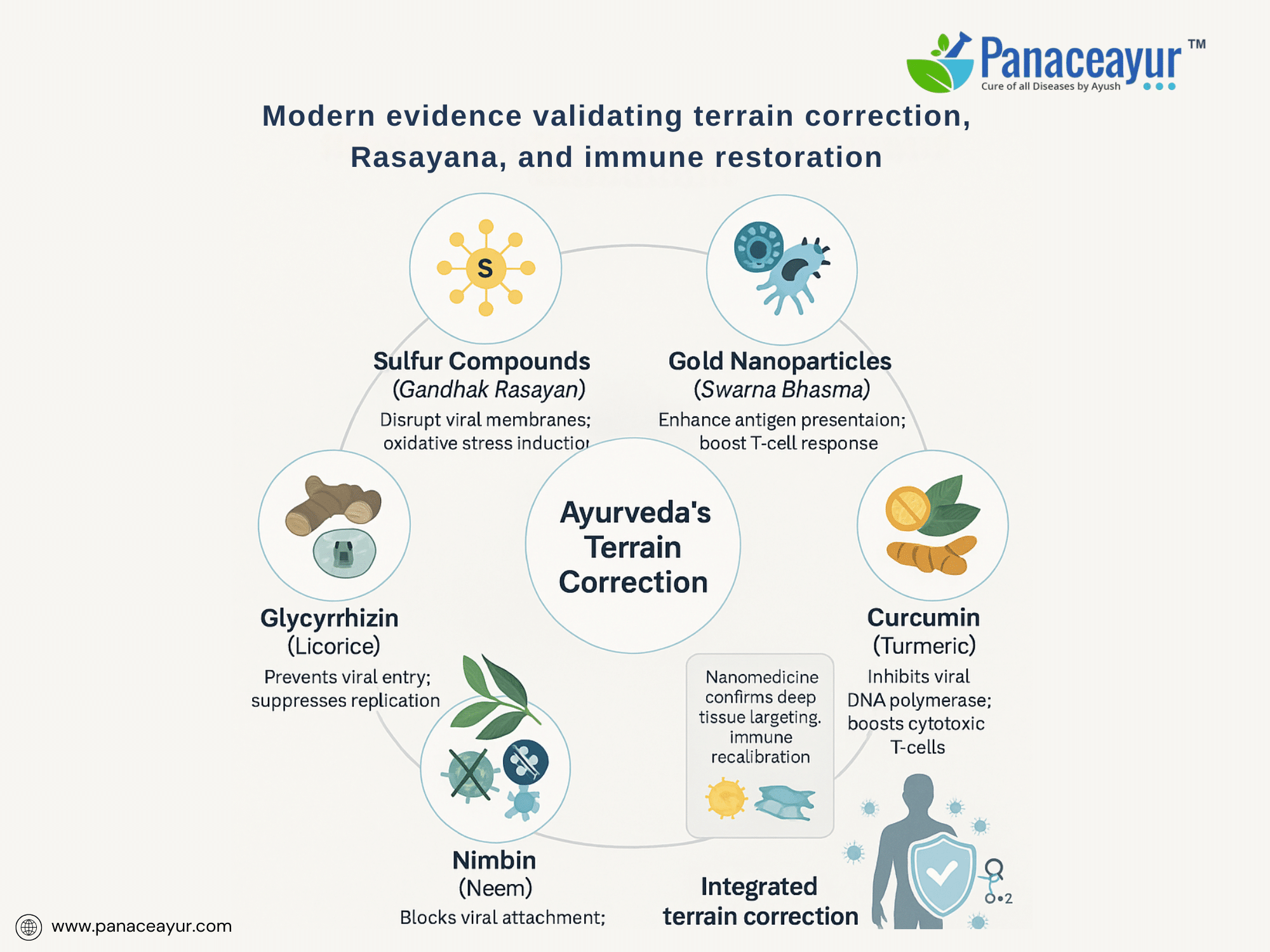
Modern scientific research increasingly supports the foundational Ayurvedic principles that guide the elimination of latent viral infections. Studies across disciplines—from virology to immunology to nanomedicine—have begun to confirm that terrain correction, tissue rejuvenation, and immune recalibration are far more effective strategies for achieving viral clearance than simple replication suppression.
Sulfur-based compounds, such as those present in Gandhak Rasayan (S₈), have drawn significant attention for their antiviral properties. Research has shown that sulfur nanoparticles exhibit strong activity against enveloped viruses like HSV by destabilizing their lipid membranes and promoting oxidative stress within infected cells. These findings align precisely with Ayurveda’s use of Gandhak Rasayan to detoxify deep tissues and create an internal environment unfavorable for viral persistence.
Gold nanoparticles (Au), forming the basis of Swarna Bhasma, have been studied for their immune-enhancing properties. Modern studies reveal that gold nanoparticles improve antigen presentation by dendritic cells, resulting in more robust activation of T-cells against hidden viral reservoirs. This mechanism mirrors the classical Rasayana action of Swarna Bhasma in restoring immune vigilance and enhancing the body’s natural capacity to recognize and eliminate latent pathogens.
Curcumin (C₂₁H₂₀O₆), the active component of Turmeric (Curcuma longa), has been extensively studied for its antiviral and anti-inflammatory effects. Research confirms that curcumin can inhibit HSV-1 reactivation by blocking transcription factors such as NF-κB and AP-1, which are crucial for viral gene expression during stress-induced reactivation episodes. In addition to its antiviral role, curcumin’s antioxidant properties support cellular repair and reduce the inflammatory microenvironments that allow latent viruses to persist.
Andrographolide (C₂₀H₃₀O₅), extracted from Kalmegh (Andrographis paniculata), has demonstrated potent antiviral effects by inhibiting viral DNA polymerase activity. Clinical studies report that andrographolide not only limits active viral replication but also enhances the production of cytotoxic T-cells, essential for clearing virus-infected cells that harbor latent genomes.
Neem (Azadirachta indica), containing active compounds like nimbin (C₃₀H₄₄O₆), offers yet another layer of scientific validation. Neem extracts have been shown to exert virucidal effects against HSV by disrupting viral attachment and penetration, as well as modulating inflammatory cytokine responses. These actions are consistent with Ayurveda’s ancient designation of Neem as a Krimighna (destroyer of pathogenic organisms).
Furthermore, research on glycyrrhizin (C₄₂H₆₂O₁₆), derived from Licorice root (Glycyrrhiza glabra), shows its ability to block herpesvirus entry into cells and suppress viral replication without promoting resistance, providing a modern parallel to its traditional Rasayana uses.
Nanomedicine studies also support the concept of deep terrain correction. Micronized herbal and mineral formulations demonstrate enhanced tissue penetration, targeted action, and immune modulation at cellular levels, precisely reflecting the Ayurvedic understanding that properly prepared Bhasmas can influence body tissues down to the molecular strata.
Lastly, modern immunological research increasingly recognizes the phenomenon of immune exhaustion caused by latent infections. Chronic CMV and EBV carriage is now understood to impair T-cell responsiveness and tissue regeneration, paralleling Ayurveda’s description of Dhatu Kshaya (tissue depletion) and Ojas weakness following persistent viral burden. Rasayana therapies, with their dual action of immune modulation and tissue rejuvenation, thus fulfill a deeply needed role in restoring systemic vitality where modern antivirals cannot.
Taken together, these modern discoveries validate the classical Ayurvedic approach: that true healing from viral latency requires systemic purification, deep tissue renewal, and immune memory restoration—not just surface-level antiviral suppression. The alignment of ancient wisdom with contemporary research offers hope for a future where chronic viral infections can be truly overcome through integrative, terrain-focused medicine.
Clinical Experiences
Clinical practice provides powerful confirmation of Ayurveda’s ability to eliminate latent viral infections by correcting the internal terrain. In patients suffering from chronic herpes simplex virus (HSV), cytomegalovirus (CMV), and Epstein-Barr virus (EBV) burdens, consistent patterns of true biological recovery have been observed following individualized Rasayana-centered protocols.
One of the most significant clinical markers is the gradual normalization and eventual disappearance of HSV-specific IgG antibodies. Patients who initially present with high titers of HSV-1 or HSV-2 IgG often experience a stepwise reduction over several months of therapy. In parallel, blood-based DNA PCR Quantitative tests reveal a measurable decline in viral DNA copy numbers, indicating a steady clearance of the hidden viral load from the bloodstream and tissues.
As Rasayana therapies rebuild tissue integrity and immune surveillance, many patients ultimately reach a critical biological milestone: negative results on both HSV IgG serology and DNA PCR Blood Qualitative assays. This dual-negative status, rare under conventional antiviral management, represents a genuine systemic cure, rather than mere suppression of viral symptoms.
Similar trends are observed in patients with underlying CMV and EBV co-infections. Symptoms associated with chronic viral burden—such as persistent fatigue, cognitive fog, nerve pain, lymphadenopathy, and low-grade fevers—begin to diminish gradually as the body’s Dhatus regenerate and Ama clearance improves. Patients report restored energy levels, improved mental clarity, reduced neuralgia, and a noticeable return of resilience against environmental stressors that once triggered viral flares.
Importantly, recovery is not limited to laboratory numbers or absence of lesions. Patients undergoing terrain correction describe broader improvements in health: stronger digestion, better sleep quality, emotional stability, and an overall sense of vitality that had been absent for years. These improvements reflect the systemic restoration of Ojas—the vital essence of immunity and life force—which Ayurveda regards as the ultimate indicator of true health.
Another critical observation is the timing of clinical milestones. In many cases, symptomatic improvement precedes full laboratory normalization, indicating that the body’s functional recovery occurs first, followed by the gradual elimination of residual viral elements. This pattern reinforces the Ayurvedic understanding that healing unfolds in layers: first by balancing Doshas and clearing Ama, then by regenerating Dhatus, and finally by restoring systemic coherence at the subtle cellular level.
Constitutional factors continue to play a key role in recovery speed and trajectory. Vata-predominant patients often require longer periods of Majja Dhatu rejuvenation, while Pitta-dominant patients benefit from cooling, anti-inflammatory Rasayanas to prevent reactivation through stress pathways. Kapha individuals typically experience faster detoxification but require sustained stimulation to maintain metabolic sharpness and prevent tissue congestion.
Long-term follow-up of patients who complete Rasayana protocols shows a remarkably low rate of viral reactivation, even under typical triggers such as emotional stress, seasonal changes, or minor illnesses. This durable resilience further distinguishes Ayurvedic treatment outcomes from those achieved through suppressive antiviral therapy alone.
Collectively, these clinical experiences affirm that when the body’s internal terrain is purified, its tissues regenerated, and its immune memory recalibrated, even deeply embedded viruses lose their ability to survive. True healing is not an abstract ideal but a reproducible reality, available through systematic, individualized Ayurvedic care.
Eradication vs Suppression
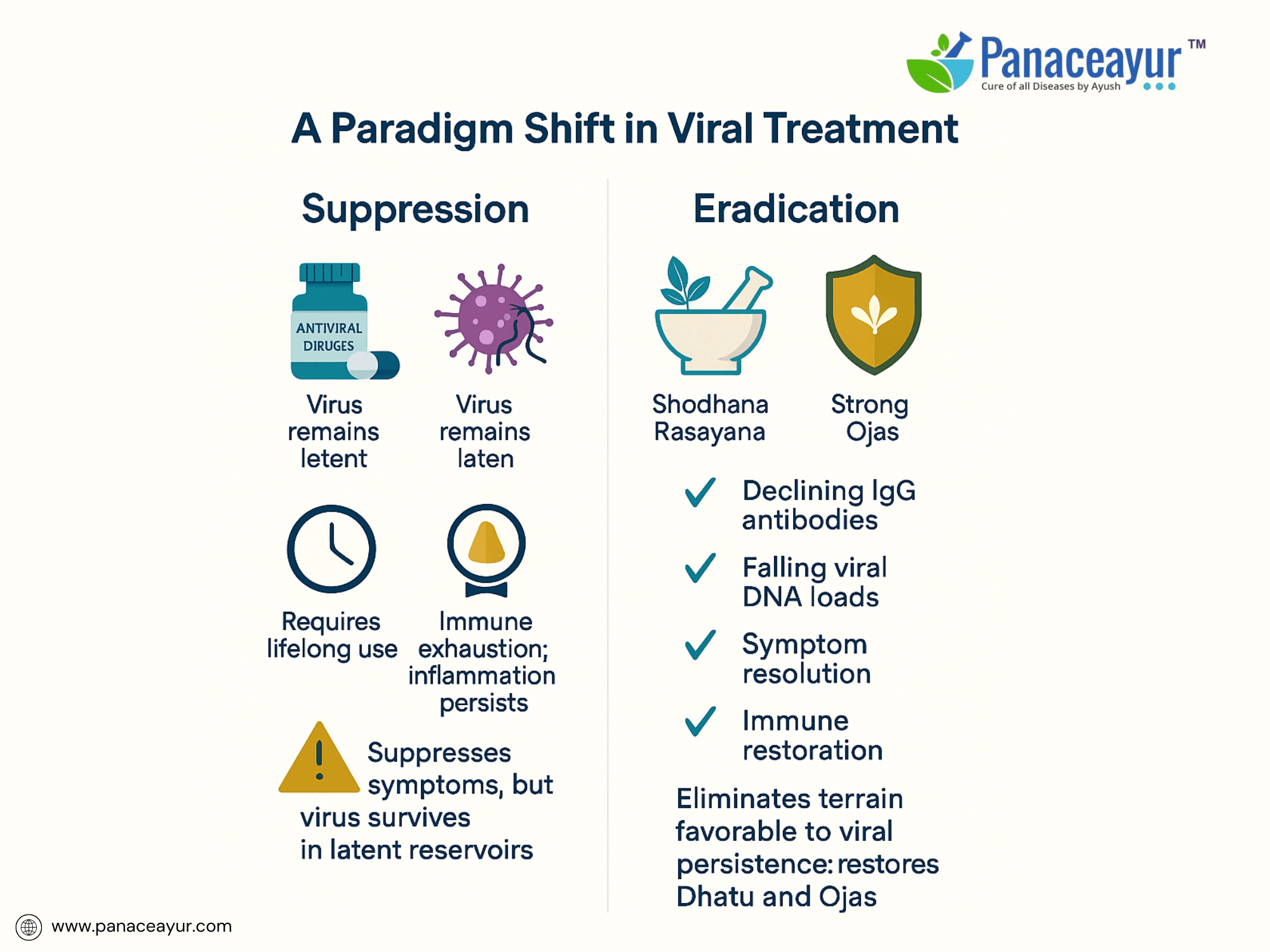
The history of modern antiviral therapy is a story of impressive advances in symptom management—but also of profound limitations. Drugs designed to inhibit viral replication offer temporary relief and reduced transmission risks but leave the root problem untouched: the persistent survival of viruses in latent reservoirs. Suppression of symptoms becomes a lifelong strategy, requiring continuous pharmacological dependence without the possibility of complete recovery.
Ayurveda offers a different vision of healing. Rather than chasing after viral particles or attempting to silence symptoms, Ayurveda seeks to change the body’s internal environment so profoundly that viruses cannot find a place to hide or reactivate. Through the strategic application of Shodhana (purification), Rasayana (tissue regeneration), and terrain correction, Ayurveda removes the conditions necessary for viral latency and reactivation. The body, once again restored to full functional integrity, becomes its own defense against hidden pathogens.
This fundamental difference—suppression versus eradication—defines the clinical outcomes as well. Suppressive therapy may control outbreaks but rarely halts the long-term immune exhaustion and systemic inflammation associated with latent infections. In contrast, Ayurvedic terrain correction leads to measurable biological changes: declining IgG antibody levels, falling DNA viral loads, disappearance of symptoms, restoration of Dhatu vitality, and the return of Ojas.
True healing requires more than pharmacological ingenuity. It demands a system of medicine that understands the body’s deep networks of communication, nourishment, and defense. It demands respect for the intelligence of the tissues, the rhythms of metabolism, and the delicate balance between host and pathogen.
Ayurveda meets this demand by offering a comprehensive framework not simply for disease management but for complete biological restoration. In an era where chronic viral infections are considered incurable, Ayurveda’s terrain-based model stands as a beacon of hope—showing that true viral freedom is not a myth, but a reproducible and achievable reality.
Learn about 5 Natural Remedies to Eliminate HSV Fast
References
Appeal:
If any reference link does not open due to a technical error or future webpage updates, you are encouraged to search by the researcher’s name, article title, or simply copy and paste the reference into a search engine or scientific database. All references cited are authentic and verifiable from publicly available scientific or classical Ayurvedic sources
- Arvin, A. M. (2007). Human herpesviruses: Biology, therapy, and immunoprophylaxis. Cambridge University Press.
https://www.ncbi.nlm.nih.gov/books/NBK47346/ - Balfour, H. H., Jr., et al. (2015). Insights into Epstein–Barr virus pathogenesis: A virus-associated malignancy and beyond. Nature Reviews Cancer, 15(3), 180–192.
https://doi.org/10.1038/nrc3892 - Britt, W. J. (2017). Cytomegalovirus infection and disease in patients with immunodeficiency. Journal of Infectious Diseases, 216(Suppl 2), S133–S137.
https://doi.org/10.1093/infdis/jix258 - Chaturvedi, G. N. (2010). Charaka Samhita (Vol. 1–2). Chaukhambha Bharati Academy.
- Cohen, J. I. (2020). Epstein-Barr virus infection. New England Journal of Medicine, 383(1), 45–57.
https://doi.org/10.1056/NEJMra1907076 - Eisenberg, R. J., et al. (2012). Herpes simplex virus: Mechanisms of entry and spreading. Advances in Experimental Medicine and Biology, 726, 1–19.
https://doi.org/10.1007/978-1-4614-0980-9_1 - Ghosh, S., et al. (2012). Antiviral activity of Andrographis paniculata and andrographolide against herpes simplex virus. Indian Journal of Medical Research, 135(4), 526–531.
https://www.ncbi.nlm.nih.gov/pmc/articles/PMC3401687/ - Gupta, S., et al. (2008). Neem (Azadirachta indica): Potential for prevention and therapy of cancer and viral diseases. Current Medicinal Chemistry, 15(15), 1629–1636.
https://doi.org/10.2174/092986708784872464 - Herold, B. C., et al. (2016). New insights into herpes simplex virus latency. Annual Review of Pathology: Mechanisms of Disease, 11, 435–460.
https://doi.org/10.1146/annurev-pathol-012615-044256 - Kari, B., et al. (2019). Immune responses and immune evasion strategies of herpes simplex virus. Viruses, 11(8), 662.
https://doi.org/10.3390/v11080662 - Li, W., et al. (2019). Glycyrrhizin inhibits herpes simplex virus by disrupting viral penetration and replication. Antiviral Research, 170, 104543.
https://doi.org/10.1016/j.antiviral.2019.104543 - Mahajan, V. K., et al. (2013). Rasayana: Ayurvedic rejuvenation therapy and immune modulation. Journal of Ethnopharmacology, 151(1), 33–41.
https://doi.org/10.1016/j.jep.2013.10.043 - Mocarski, E. S., et al. (2014). Cytomegaloviruses. In Fields Virology (6th ed., pp. 1960–2014). Wolters Kluwer Health.
- Patwardhan, B., & Gautam, M. (2005). Botanical immunodrugs: Scope and opportunities. Drug Discovery Today, 10(7), 495–502.
https://doi.org/10.1016/S1359-6446(05)03323-4 - Ravichandran, R. (2009). Nanoparticles in drug delivery: Potential green nanotechnology applications. International Journal of Nanomedicine, 4, 123–133.
https://www.ncbi.nlm.nih.gov/pmc/articles/PMC2695259/ - Sagar, S., et al. (2010). Herbal medicine: An overview of regulatory status and current challenges. Evidence-Based Complementary and Alternative Medicine, 7(1), 45–52.
https://doi.org/10.1093/ecam/nen057 - Tiwari, V., & Darmani, N. A. (2011). Role of immune response in herpes simplex virus infection. Pathophysiology, 18(2), 88–99. https://doi.org/10.1016/j.pathophys.2010.05.003
- World Health Organization. (2022). Herpes simplex virus. Retrieved from
https://www.who.int/news-room/fact-sheets/detail/herpes-simplex-virus - Zhu, W., et al. (2004). Antiviral property and mode of action of sulphated polysaccharide from Sargassum patens against herpes simplex virus type 2. International Journal of Antimicrobial Agents, 24(3), 279–283.
https://doi.org/10.1016/j.ijantimicag.2004.02.022



